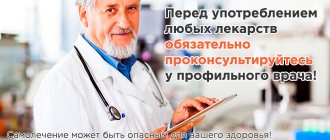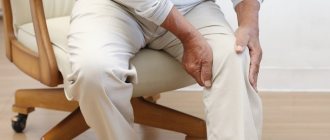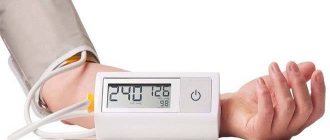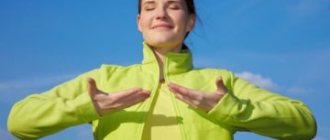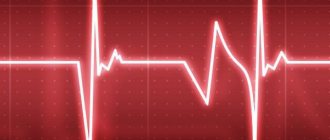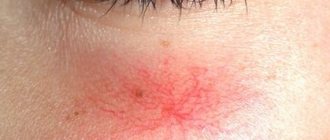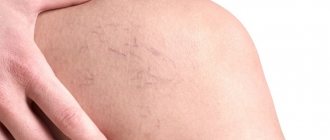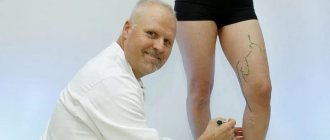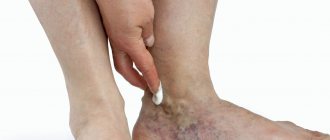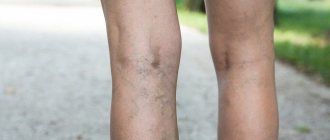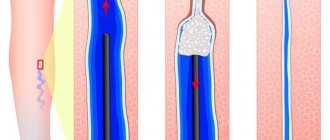General principles
You can improve blood supply to the lower extremities by following the standard algorithm of actions: seeing a doctor, diagnosis and treatment. In other words, pathology requires adherence to a specific plan:
- it is possible to stimulate blood flow only if a specific reason for its decrease is established; in this case, one cannot do without a specialized specialist; the first step is to seek qualified medical help in order to clearly understand the integrity of the changes occurring in the body;
- recommendations received from a doctor must be followed systematically, otherwise there will be no result;
- improving blood flow in the legs is, as a rule, complex in nature, combining several correction principles: medications, dosed physical activity, a balanced diet;
- maintaining a sense of proportion is the main feature of the strategy, the key point;
- improving blood circulation in the vessels of the legs can only be achieved by a competent specialist who is able to develop an individual scheme of prevention or early therapy based on comprehensive medical knowledge;
- You need motivation, a desire to work sometimes for a long time to cope with the situation, a change in lifestyle and thinking.
Only the ability to adhere to all of the listed principles will allow you to achieve the desired result.
Traditional medicine
How to improve blood circulation in the legs? Folk remedies can help solve this problem only if the disease is mild. In more serious cases, the help of a doctor is necessary.
The greatest effect is achieved by alcoholic tinctures of lilac or chestnut flowers. To do this, the flowers are placed in a half-liter jar, filled almost to the top, and filled with vodka or alcohol, diluted by half. The jar is closed with a plastic lid and placed in a dark place for two weeks. During this time, the liquid turns dark brown. It should be strained, after which it should be rubbed on the inner surface of the thighs and below.
For these purposes, chestnut fruits are also used, which are first flattened. The preparation and use of the tincture is carried out in the same way.
How to improve blood circulation in the legs of older people? All of the above methods are effective for people of all ages.
Lifestyle correction
Correction of habitual existence is the basis for normalizing blood supply to the legs, which can be restored due to the restoration of vascular tone. But this is not always enough.
First of all, you should give up smoking - a provocateur of toxic vascular paralysis with nicotine (according to statistics, without timely correction, necrosis of leg tissue with gangrene and amputation occurs in 100% of cases) and alcohol, which destroys the body, stenosis of blood vessels, causing ischemia of tissues and organs, the development of hypertension , atherosclerosis, thrombophlebitis, AMI, stroke (maximum alcoholic beverages/day - 30 grams per day, not on an ongoing basis).
In addition, you should minimize the intake of caffeine-containing drinks: systematic consumption of coffee and surrogates leads to vascular spasm and the risk of stroke or heart attack. It makes sense to replace coffee with chicory or other invigorating analogues.
Physical activity is equally important to improve blood flow in the lower extremities. This could be exercise therapy - a special set of physical exercises recommended by the doctor, swimming, walking, running.
Normalization of body weight is a condition without which stimulating blood flow in the legs is not only useless, but also dangerous: inadequate load on the vessels with excess weight leads to serious complications. We must not forget that excess weight is a consequence of lipid metabolism disorders, which is a priori a trigger for atherosclerosis with ischemia of leg tissues and trophic disorders.
A balanced diet is the background of the changes taking place in the body: you need to give up excess animal products in favor of plant components, make meals in fractions, correctly calculate the drinking regime (40 ml of clean water per 1 kg of weight).
Anyone who is associated with standing on their feet in a static position should think about changing their profession or correctly alternating statics and dynamics, since prolonged lack of movement and static load are the cause of the development of atherosclerosis, thrombosis, venous insufficiency and varicose veins. Half an hour of light exercise such as walking and leg swings is enough to improve blood flow in the legs and stimulate the functioning of the venous valves. Physical inactivity has the same consequences.
Psycho-emotional stress is closely related to physical activity: the release of adrenaline, cortisol, angiotensin into the blood provokes vasospasm, and an increase in blood pressure is no worse than lifting an unbearable load. In the long term, this means degeneration and destruction of blood vessels, impaired blood flow in the lower extremities, varicose veins and other troubles. Physical hyperload works almost the same way.
Uncomfortable shoes and tight clothing cause compression of the tissues of the lower extremities and impair the movement of blood through the vessels. Compression jersey, which can be mistaken by an amateur for items of clothing that correct blood flow, is indicated only for certain disorders; on the recommendation of a doctor, it is therapeutic and performs completely opposite functions than skinny jeans, for example.
Kinesitherapy - massage and exercise therapy - serve to improve blood circulation in the legs, the exercises are selected by the doctor, but you can also perform a number of actions yourself:
- walking in place for a minute;
- rotation of the ankles or knees clockwise and counterclockwise in a sitting position 10 times;
- alternate leg raises;
- chaotic shaking of the lower extremities.
Massage is carried out in a system, in courses. The essence is to relieve muscle strain, balance muscle tone and blood flow through artificial activation of venous valves.
Nutrition
In 1992, scientists discovered that administering omega-3 fatty acids to experimental animals in the form of fish oil increased blood flow to the liver, which improved blood flow and prevented cardiovascular disease. Most omega-3 acids are found in seafood and sea fish: perch, salmon, shrimp, shellfish. Therefore, these products are recommended as the basis for a healthy diet for anyone who suffers from problems with blood flow in the lower extremities, especially in the early stages of the development of the pathological process.
In 2011, reliable scientific evidence emerged that two years of daily intake of folic acid and vitamin B12 stimulates blood flow in heart patients. That is, a priori it helps to increase blood circulation in the legs. Folic acid is found in leafy vegetables, peanuts, peas, and B12 in fish, meat, eggs and milk.
In 2004, American cardiologists published a study that showed that vitamin C stimulates blood flow in smokers, activating the formation of new capillaries and restoring old ones. This feature of this amazing vitamin is used to stimulate blood flow in the lower extremities, prescribing more ripe citrus fruits, kiwi, mango, melon, and green vegetables.
Vitamin E also improves blood circulation, including that of the legs, because it is an antioxidant (rejuvenates blood vessels), a detoxifier (removes toxins), dilates blood vessels, and prevents blood clotting: vegetable oils, leafy vegetables, nuts, and seeds are the main sources of vitamin E.
If we talk about herbs and nutritional supplements, then priority goes to cayenne pepper, which improves blood circulation, thins the blood, preventing thrombosis, lowers blood pressure, and prevents the development of atherosclerosis (the product is best suited for people whose feet are constantly cold).
Foods high in potassium activate blood circulation and stimulate the removal of excess water, so the diet to activate blood flow in the legs includes bananas, avocados, seaweed, cocoa, seeds, radishes, broccoli, tomatoes, carrots, pumpkin, ginger.
Basic rules of treatment
If you experience discomfort in your legs, you should definitely contact a specialist.
Using procedures such as ultrasound or angiography, as well as MRI, the doctor gets a complete picture and develops a treatment plan.
If the circulatory disorder has an initial form, the use of traditional methods of treatment and gymnastics will be quite sufficient. For more advanced forms of pathology, surgical treatment is performed.
For this reason, it is so important to determine the presence of the disease at the earliest stage and take optimal measures. Quite often, the problem is solved after changing your lifestyle, after completely giving up bad habits.
Exercises
There are many exercises that stimulate blood circulation in the lower extremities. The simplest of them are:
- stand on your toes and walk on them for a few seconds, maybe three or four approaches;
- walk on your heels for several meters;
- imitate riding a bicycle while lying on your back or drawing circles in the air with your legs, doing “scissors”;
- lying on your back, raise your legs at an angle of 90 degrees, bend your knees and straighten: 10-20 times;
- sitting on a chair with a straight back, placing your feet on the floor and raising your heels, without lifting your toes from the floor, you can move your ankles up and down;
- take the stairs without an elevator;
- walk for half an hour/day.
Ways to Improve Blood Flow
To improve blood flow, make contrast baths for the hands and feet. You need to take 2 basins, fill one with hot water and the other with cold water. Place your feet in hot water and your hands in cold water. After a couple of minutes, do the opposite, immerse your feet in cold water and your hands in hot water. You need to do this procedure several times, and then rub your hands and feet well with a towel.
You should also do exercises that activate blood flow:
- Sit on the floor, hands on the back of your head, turn your whole body 20 times to the left and 20 times to the right.
- Sit at the table, grasp the tabletop with your fingers and squeeze it tightly, while stretching forward one or the other leg in turn. After charging is complete, release your fingers with a jerk.
When working sedentarily, you should try to sometimes get up from your seat, walk around, do squats, and massage your fingers. You can place a small stool under the table to rest your feet on. This will make it easier for blood to rise from the legs up to the heart.
In addition, it is necessary to normalize body weight, which will reduce the load on sore legs and have a beneficial effect on blood vessels. Avoid heavy loads, but still move - walk 3-5 km every day, without sitting down and walking without stopping.
Before going to bed, rub rosemary oil into the skin of your hands and feet, massaging them well. This improves blood circulation. In summer, the procedure can be done every other day, and in cold weather - every evening.
You should pay attention to your diet, more often consume foods that improve blood circulation, namely nuts, garlic, dark chocolate, olive oil, chili peppers, fruits containing vitamin C.
Drug therapy
Treatment of circulatory disorders in the lower extremities is also carried out with drugs:
- statins (Atoris, Rosuvastatin, Atorvastatin) – prevention of atherosclerosis;
- antiplatelet agents (Aspirin, Thrombo-ASS, Cardiomagnyl) - restore blood fluidity;
- anticoagulants act similarly, but are taken only with laboratory monitoring of the state of the blood coagulation system: Heparin;
- strengthen vascular walls Anavenol, Pentoxifylline;
- phlebotonics (Detralex, Venarus, Troxevasin) – improve the quality and speed of venous-lymphatic outflow;
- diuretics (Triampur, Furosemide, Spironolactone) - minimize the load on the heart and circulatory system, removing excess fluid.
The root cause of poor circulation in the legs must be corrected: diabetes, liver, kidney, heart failure, hypertension.
Surgical methods
Medicines to improve blood circulation in the legs are primary therapy. Surgery is a last resort. There are several methods of surgical intervention:
- stenting, vascular plastic surgery - artificial expansion of the lumen of a vessel with a balloon or stent, replacement of the affected area with a prosthesis;
- bypass - creating a bypass to provide leg tissue with nutrition and oxygen;
- radiofrequency ablation – replacement of a vein fragment;
- sclerotherapy - the introduction of a sclerosant substance to empty the vessel, turning it off from the main blood flow and creating conditions for the development of collaterals;
- mechanical removal of a blood clot from a vessel.
